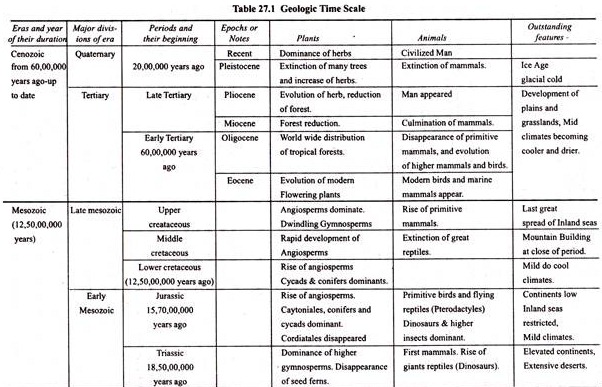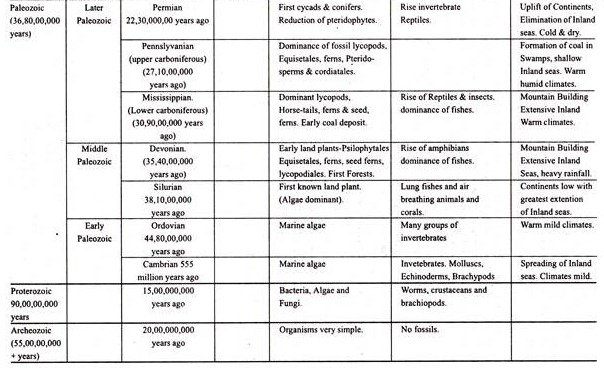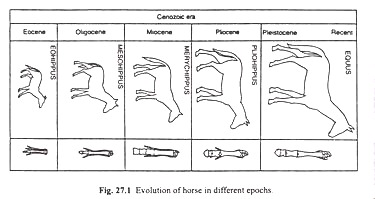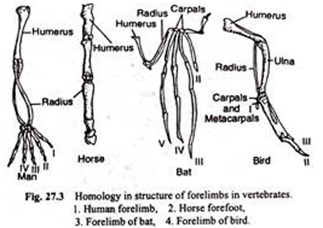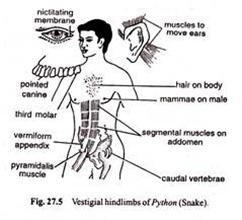ADVERTISEMENTS:
The following points highlight the top seven evidences supporting organic evolution. Some of the evidences are: 1. Evidences from Palaeontology, 2. Evidences from Comparative Morphology, 3. Evidences from taxonomy, 4. Evidences from comparative physiology and biochemistry, 5. Evidences from Embryology-Doctrine of recapitulation or Biogenetic laws and few others.
Evidences Supporting Organic Evolution:
- Evidences from Palaeontology
- Evidences from Comparative Morphology
- Evidences from Taxonomy
- Evidences from Comparative Physiology and Biochemistry
- Evidences from Embryology-Doctrine of Recapitulation or Biogenetic Laws
- Evidences from Biogeography (Distribution of Organisms in Space)
- Evidences from Genetics and Cytology—Experimental Breeding and Hybridization
Evidence # 1. Evidences from Palaeontology:
Palaeontology, the science of fossils, provides the strongest and direct evidence in support of the theory of organic evolution. Fossils are dead remains of plants and animals preserved in the rocks of the remote past.
Process of Fossilization:
ADVERTISEMENTS:
Fossils are found in the sedimentary or stratified rocks. They were formed from those organisms or fragments of organisms which became entombed (covered) under the sediments before they had a chance to disintegrate completely.
Complete preservation is very rare and incomplete preservation is directly proportional to resistance of tissues of various disintegrating fragments. It is very seldom that a plant or animal may be found preserved in one piece with its several parts attached and all the tissues intact.
Generally different parts become detached before fossilization. Leaves, seeds and fruits become detached from the twigs on which they grew and stems break loose from the roots, and further a proportion of softer tissues may be decayed before the fossilization comes into play.
The study of fossils is mainly, therefore, of the unconnected parts, some of which are usually not completely preserved. Often the parts of many different kinds of plants are mixed together indiscriminately.
ADVERTISEMENTS:
Pieces of plants and animals are brought by wind and rainfluries into rivers, lakes or shallow sea where they settle at the bottom and then they are covered by sedimentary sits. These organic parts are usually preserved by sedimentary beds of the earth light-heartedly.
It is for us to sort them as best as we can. Hard parts of animals such as bones, shells and teeth are preserved unaltered. Very rarely the whole organism may be preserved as such.
Types of Fossils:
Fossils are of the following three types:
(i) Petrified fossils or petrifactions,
(ii) Moulds of animals and plants, and
(iii) Compression and impression.
(i) Petrified fossils:
Sometimes, fossilized materials are converted into stones because original protoplasmic substance of each cell is replaced by mineral particles. The important mineral compounds which replace the cytoplasmic components of fossilized materials are iron oxide, iron pyrites, sulphur, silica, malachite, etc.
Petrified fossils show nearly exact external forms, internal structure and sometimes substances of original plants or animals often in great detail.
ADVERTISEMENTS:
(ii) Natural moulds of plants and animals:
These are formed in mud and sand which become hardened into slates or stones. In these fossils, central portion of the material is not preserved at all. The cavity (mould) formed as a result of disintegration of central tissue is subsequently filled up with hard minerals and mud, thus forming an incrustation or cast of the original structure.
Soft bodied animals, tree trunks, stumps, fruits and seeds are preserved in this way. Many fossil plants and animals are known only from their casts and impressions they have left. Casts are valuable fossils, because they give good idea about external shapes of the organisms.
(iii) Compression and impression:
ADVERTISEMENTS:
These are found in sedimentary deposits. The external form of materials is modified by vertical pressure of overlying sediments in which the material is entombed. In compression, original shape of materials is changed and the material becomes flattened. If the plant part is cylindrical it would be changed to elliptical shape.
If rock containing compressed fossils is broken into two halves in such a way that one half contains fossils and the other half bears only impressions or imprints of the fossils, the half with fossils will be called positive rock piece and the other half having imprints of the fossils will be called negative piece or impression piece.
The study of fossils shows that the animals and plants have appeared on this earth in a series of progressive complexity of organizations. If the evolution has taken place, the students of geology and pilaeontology may be inclined to think that they should be able to get a complete series of animals and plants representing all their changes which took place in them in the past.
If such a complete geological record existed it would undoubtedly be conclusive evidence in favour of evolution, but it is not the case and there is imperfection in the geological record. It is in fact rarely ever complete. There are, however, a few cases in which record are so complete that the entire evolutionary history of the group can easily be traced.
Geological Time-Table:
ADVERTISEMENTS:
The geological time-table is a calendar of the earth’s past history which shows that:
1. None of the organisms of the past were exactly similar to those found today.
2. All fossils did not appear at the same time but in different periods.
3. The older forms are relatively simpler and comparable, at least, with unspecialized member of the living phyla.
ADVERTISEMENTS:
4. There has been a gradual progress from the simpler to complex forms in time.
5. A new type appearing in one period became predominant in the latter period and that finally disappeared. Though there have been extinctions of many large groups, once a major phylum was established that has persisted with more or less number of species living today.
6. The mammals among the animals and angiosperms in plants are the latest products of evolution.
The geological approach to the subject of palaecontology is mainly from the standpoint of the correlation of rock formations to evolutionary events. Fossils are markers of the geological times. Rocks in widely separated localities containing similar floras and faunas are generally thought to be approximately of the same age.
ADVERTISEMENTS:
The largest divisions of geological time are called eras. The eras are recognized on the basis of presence of major groups of plants and animals in their rocks. Eras are divided into periods and periods are divided into epochs. A brief summary of geological time scale and succession of various representative groups of plants and animals at different times have be given in the Table 27.1.
Evolution of Horse:
Perhaps the most thoroughly known phylogeny of any vertebrates is that of horse (Fig. 27.1). The history of the horse covers a period of 60,000,000 years. The first horse appeared in the eocene period about 6 million years ago as a small horse like animal which was about 12″ high and had four toes and a remain of 5th toe.
That extinct animal is named eohippus. The second stage is represented by orohippus which was a little more advanced than eohippus, having lost the remains of 5th digit of the foot.
The next stage is represented by the three toed horse called mesohippus which made its appearance in the oligocene period. The height of animal was double that of an eohippus. The teeth had also become more complex.
Mesohippus was later replaced by merychippus in the miocene period. Merychippus represented a transitional stage between modem horse and mesohippus.
Pliohippus, the first single toed horse, appeared in Pliocene. It was about 40 inches in height. The modem horse equus first appeared in the upper pleistocene and now represents the final stage of evolution of horse. This illustrated by a series of steps in Fig. 27.1.
The history of evolution of horse in wider sense is merely an example of the evolution of a genus. But, many other fossils are known which clear our notion about the evolution of different classes of vertebrates and fill in the gaps between two different groups. Fossil genus archeopteryx, for example, links birds with reptiles (Fig. 27.2).
Similar such examples are known in palaeobotany also. For example, psilophytales group in pteridophyta forms a connecting link between non-vascular and vascular plants and similarly seed ferns (pteridosperms) definitely form a connecting link between forms and cycadales.
Fossil record, however, is imperfect. This imperfection may be due to the following reasons:
(i) Incomplete preservation of the organic parts. In the process of fossilization hard parts are preserved with little change but the softer parts are incompletely preserved.
(ii) Fragmentary nature of the fossilized organic parts.
(iii) Even if the organisms are preserved well, they may be destroyed by physical agencies, such as, high pressure, strong heat, volcanoes and so on.
(iv) Some organisms which might have been in imperfect stage of formation might not have been fossilised.
Evidence #
2. Evidence from Comparative Morphology:
The individuals of different groups of plants and animals have the same fundamental structural plan. Series of corresponding organs are only slightly modified according to the different functions they perform. It is a common belief of biologists that morphological similarities are indicators for common ancestry and common ancestry means close relationship.
The morphological evidences for evolutions have been obtained from the studies of floral morphology, seed structure, wood anatomy of plants and from the comparative studies of organ systems in animals.
Some of the morphological evidences in support of organic evolution are enlisted below:
(i) Among animals, studies on organ systems make it evident that structures in question show a common fundamental structural plan. Only minor changes in the structure have brought alterations in the morphology of organs.
Vertebrae in all higher vertebrates, for example, show the same fundamental structural plan. The vertebrae originate from similar embryonic rudiment. In less evolved vertebrates, vertebrae are simple but in highly evolved members, these are modified to a high degree but the basic structural plan remains unaltered.
(ii) The appendages of crustacea are built fundamentally on the same bimarous pattern and so they are considered to be serially homologous.
(iii) The forelimbs of all vertebrates are built up on the same pattern as they all have the same bones namely humerus, radius, ulna carpels, (Fig. 27.3). These bones differ in different animals because they are modified and specialized according to different modes of life, such as, swimming’ walking, jumping, flying, climbing, digging, etc. Such structures are said to be homologous organs.
(iv) Similarities in other organ system of vertebrates:
Practically every organ system present some basic structural similarities among the vertebrates. The alimentary canal, nervous system excretory system and reproductive system of the vertebrates are built on similar generalize plans. They show progressive changes from fish to mammals. Heart is two chambered in fishes three in amphibians and completely four chambered in fishes, birds and mammals.
Homology and Analogy:
Organs that are similar in their structural plan and in their embryonic developments are called homologous organs. Wings of birds, bat and pterodactyle are homologous because structurally and embryologically they are similar (Fig. 27.4). Structures which are similar in functions but different in morphology and origin are called analogous organs.
The phylloclade of ruscus and cladodes of Asparagus are similar in functions and origin, so they are homologous, but both of them are analogous to leaves, because they are modified stems. In plants, the flowers are supposed to be homologous to a branch and its various parts, such as, sepals, petals, stamens and carpels are homologised with leaves of a twig.
The homologous organs are some of the strongest morphological proofs in support of the theory of organic evolution.
Vestigial Organs:
Vestigial organs are the structures in body that are found in reduced condition and serve no function. They, however, resemble and correspond to the same organs which are well developed and useful in other animals. The Kiwi, a flightless bird, has wings that are reduced to structures called halters. In some of the snakes (pythons), vestiges of the pelvic girdles are found Fig. 27.5).
In man, there are approximately ninety vestigial organs. Presence of tail: structure in some rare children is a case vestigial organ. This suggests that ancestors of human might have had tails. Vermin-form appendix of human is degenerated caecum which is very well developed and functional in herbivorous animals, such as, cows, goat, rabbits.
In birds and humans the nictitating membranes are present in vestigial form fig. 27.7).
The following are important examples of vestigial organs among plants Fig. 27.6):
1. Staminodes in flowers.
1 Specialization of stamens into nectaries in certain families of angiosperms.
3. Rudimentary leaflets in apricot (Rosaceae).
4. Reduction of leaflets into glands in apricot.
The existence of vestigial organs can be explained only if it is admitted that bring useless they are disappearing. These evidences suggest that the animals and plants are changing and becoming modified.
Evidence # 3. Evidence from Taxonomy:
Taxonomy, a science concerned with the description, naming, classification and phylogeny of plant and animals, also furnishes many evidences in support of the theory of organic evolution.
Evidence from taxonomy is based upon existence of:
(i) border line or intermediate taxonomic groups, and
(ii) Series of plants and animals from simple to complex. Although different individuals belonging particular phyla or groups have common ancestry, they possess common fundamental characters.
A bird, for example, shares many features in common. As one goes down to the lower classification in units, one finds that the species of a genus differ only in some minor characters. Classification graded series strongly supports affinities of plants and animals by lineal and common descent.
Sora forms of life form connecting link between two closely related groups, as for example, fossil group cycadofilicales (seed ferns) stood intermediate between ferns and cycads.
This group shared so characters of ferns on one hand and some characters of cycads on the other. This suggests that f« were probable ancestors of cycads and related forms. Such intermediate forms indicate the trends through which a group of organisms modified into another group.
The existence of such intermediate and transitional forms is a very strong evidence of evolution. Intergrading species are formed as result of active evolution.
The individuals of some major groups of plants and animals are simple and their organs are relatively unspecialized, but the other members of the same groups, though they retain some primitive features, are complex. The more complex plants and animals may thus be traced back to simple beginnings.
Evidence # 4. Evidence from Comparative Physiology and Biochemistry:
Basic physiological and biochemical differences and similarities in the individuals of particular plant or animal group also furnish important information regarding its relationships and ancestry.
The following facts of physiology and biochemistry support the theory of organic evolution:
(i) The Protoplasm:
The basic substance of living body contains nearly the same elements compounded from roughly the same proportions of proteins, carbohydrates, fats, water am other substances. Much the same is true with respect to the chemistry of chromosomes, appears that throughout the entire living world the chromosomes consist of basic proteins an nucleic acids. The nucleic acids are rather uniform.
(ii) Enzymes and Hormones:
In a particular group of plants or animals, similar enzymes hormones occur. This is specially true of some of the digestive enzymes in animals. In almost all the green plants belonging to diverse groups photosynthetic enzymes are the same. The indicates seemingly a common ancestry of all green plants.
(iii) Metabolites:
The presence of characteristic chemical substances, such as aromatic volatile oil in the members of rutaceae and labiatae, resins in conifers and so on, suggests that the member are closely related.
Excretory product analysis:
Analysis of the urinary wastes of animals provides some evidence of evolutionary relationship. Nitrogenous excretory waste depends upon the activity of particular kinds of enzymes which are determined by genes and have been selected during the course of evolution.
The waste products of the metabolism of purines, adenine and guanine are excreted by man and other animals in the form of uric acid, allantoin, urea and ammonia. Vertebrate’s evolution shows successive loss of enzymes for degradation of uric acid.
In the early stages of development in chick embryo first ammonia is excreted, then urea and finally uric acid. The enzyme uricase is present in the early stage of chick embryo which catalyses the first step in this degradation of uric acid but later on it disappears.
(iv) Hematological Characters:
Crystals of hematine obtained from Hemoglobin of all the specie of genus share many characteristics in common while crystals obtained from the members (different classes have characteristics which are peculiar to them. Thus, it is possible on the basis of examination of hematine crystals alone to find out relationship among the various classes of vertebrates.
(v) Comparative Serology:
Serum precipitation tests based on “antigen-antibody reactions” in the animals show many basic similarities in physiological and chemical properties of sera of different groups of animals and establish physiological relationships among them, for example, serum precipitation tests of mammals show a much greater chemical relationship between man and ape than between man and dog.
Sera of mammals are more sharply distinguished from those of other vertebrates.
(vi) Blood Groups:
The blood of human has been classified into four well known groups ‘A’, ‘B’, ‘AB’ and ‘O’ on the basis of antigen-antibody reaction. Red blood cells may carry antigen ‘A’ or ‘B’ or both ‘AB’ or ‘O’ (none) and person’s blood group is named accordingly.
Such series of blood groups have been found in many other animals also. It has been experimentally proved that bloods of horse and ass are similar in their properties. This suggests a relationship between them.
(vii) Biochemistry and Recapitulation Phosphogens:
Muscle contraction in animals is brought about by energy rich adenosine triphosphate (ATP). ATP when breaks down yields energy for the contraction and then a second energy rich compound called a phosphogen breaks and releases energy for the resynthesis of ATP.
ATP —à ADP + Phosphate + Energy
Phosphocreatine + ADP ——àcreatine + ATP
(Phosphogen).
In the muscles of vertebrates, the phosphogen is always a specific compound, creatine phosphate, whereas in most invertebrates it is argenine phosphate. Argenine and creatine are very closely related chemicals and in vertebrates the former is actually used in the synthesis of the latter. Hemichordates, the most primitive chordates, have both the phosphogens, a condition found elsewhere only in certain echinoderms.
In the embryos of shark, argentine is abundant but becomes more restricted in the adult. Thus, it is possible that creating metabolism in vertebrate is a biochemical recapitulation which is comparable to embryological recapitulation. Some interesting cases of recapitulations are seen in fishes and amphibians.
Evidence # 5. Embryological Evidences (Biogenetic Laws):
Comparative studies of the embryology show great similarity in different groups of plants and animals. Pea and bean, although quite dissimilar in adult stage, show similar embryology.
Monocots and dicots, which are quite different from each other, show similar pattern of embryo development in the beginning and it is believed that one of the two cotyledons of dicot embryo disappeared for ever, giving rise to monocot embryo. In this way, monocots might have solved from dicots.
Embryos of all multicellular animals develop from single cell (zygote) and all pass through a common series of stages, such as blastula, gastrula, and so on. The nearer the relationship of the adult structures, the greater is the similarity in the courses of embryo development. The embryos of fishes, reptiles, birds and mammals are all alike in the early stage of development (Fig. 27.8).
In the embryogenic stages they all possess two chambered heart, aortic arches, gills and gill slits which are exactly like those of the fish embryo. Adults of those animals do not retain these characteristics.
In the course of evolution, the embryonic gills were closed, the aortic arches became modified into the carotid and the other arteries and the heart became three chambered m amphibians and reptiles, then finally four chambered in birds and mammals. All these evidences indicate that amphibia, reptiles, birds and mammals have descended from some common fish-like aquatic ancestors.
It is now evident that during embryonic development all the plants and animals pass through the similar stages, their ancestors went through in the long course of evolution. Thus in brief, it can be said that the embryonic development or ontogeny is recapitulation of the ancestral history or phylogeny or in other words, “ontogeny repeats phylogeny “.
This is known as ‘Biogenetic law’ or “Doctrine d recapitulation”. Ontogeny is the development of the individual and the phylogeny is the development of the species or race. The law was propounded by E. Haeckel who was of the opinion that each of the embryogenic stages corresponds to the ancestral adult and hence provides direct evidence to the lines of descent.
The fertilized egg of higher animals can be compared with the single celled flagellate ancestors and the blastula can be compared with a colonial protozoan or some blastula-like animal which has been postulated to be ancestor of all metazoa. Recapitulations do occur but not in the way haeckel has interpreted, for the resemblances are chiefly in the embryos.
Protonema stage in mosses can be cited as an example of recapitulation in the plant. This stage apparently indicates the algal ancestry of mosses. Another example of recapitulation is found in the living cycads in which the sperms are ciliated. This condition is common in ferns and bryophytes.
Von Boer’s Principles:
It seems that in formulating his Biogenetic laws Haeckel started from Von Boer’s principles of embryonic differentiation which are perhaps more sound, more correct and better guides to the embryological evidence for organic evolution. Von Boer’s principles are as follows:
(i) General characters appear before specialized characters in the development.
(ii) From the more general characters the less general and finally the special characters appear.
(iii) During the development, embryo of an animal differs progressively from those of other animals.
(iv) Young stages of higher animal are like embryonic stages of lower animals but are not like adults of those animals.
Atavism:
The ancestral characters which are supposed to have been lost during the course of evolution may sometimes reappear in the organisms suddenly as abnormal characters. Large canine teeth in human on rare occasions and rare development of small tails in human babies are examples of atavistic characters.
The sudden appearance of atavistic characters can be explained only if it is supposed that these structures were present in the ancestors but have been lost in the modem forms during the course of evolution. The appearance of atavistic characters is governed by principles of genetics.
Evidence #
6. Evidences from Geographical Distributions of Plants and Animals:
Study of geographical distribution of plants and animals has added further evidence in favour of the theory of organic evolution.
On the basis of ecological conditions and distribution of animals, the following six zoographical regions have been recognised in the world (Fig. 27.9):
(i) Nearctic — North America down to the Mexican plateau,
(ii) Palearctic — Asia, North of Himalayas, Europe, Africa and North of Sahara desert,
(iii) Neotropical — Central and South America,
(iv) Oriental — Asia, South of Himalayas, Africa and
(v) Ethiopian — Africa South of Himalayas, and
(vi) Australian — Australia and associated Islands.
The organisms are not equally distributed in all parts of the earth. Many types are widely distributed on the earth but other species (endemic forms) tend to be restricted to their specific ranges. Places with similar climatic conditions in different regions of the world do not always possess the same type of flora and fauna, for example, elephants occur in Africa and India rim not in Brazil.
Climatic conditions of desert region in south-western United States and western Africa are similar but animals and plants in the two places are quite different.
South America and African regions both are mostly tropical and crossed by equator and they have similar habitats yet they have dissimilarities in fauna more greatly than similarities. Succulent euphorbias are common in African deserts but rare in the deserts of United States. Again, representatives of a particular group of plants or animals may occur in widely separated places, but not in the regions between them.
This uneven distribution of plants and animals on the earth cannot be explained except through evolution. Geographical barriers, such as oceans, rivers, mountains, etc. isolating groups of animals and plants give rise to divergent forms.
Generally it is seen that the floras and fauna in the regions that are isolated for only a short period of geologic time contain similar but not identical plants and animals. The longer the period of isolation of one region from another, the greater is the degree of differences among the plants and animals of the two regions.
These facts lead to the conclusion that the existing plant and animal species are descendants of the extinct forms which were of more generalized type.
When they were dispersed away from places of their origin they became modified to meet the new environment. Populations representing intermediate evolutionary changes possibly disappeared. This is the only possible explanation of the uneven distribution of plants and animals in different parts of the world.
Evidence # 7. Evidence from Genetics and Cytology:
The study of heredity process and chromosomes has contributed many good evidences which support the concept of unceasing change in the living organisms. Cytogenetical evidences in support of organic evolution are final. In fact, the evolutionary relationship is clearly reflected in the karyotype or chromosomes morphology of different species.
By selective breeding man has been able to develop different new types of domestic animals and new varieties of plants which are so much different from the wild (common) forms that they can be classified almost as separate species. In the study of hereditary mechanism of plants and animals biologists have observed the frequent, sudden and unpredictable developments of new types from the parents by mutations.
Spontaneous or induced mutations are the ultimate causes of variations. The forces of selection, natural or artificial, guide the populations to change. Evolution would be impossible if there were no means of producing new heredity characters.
The new characters arise primarily by gene mutations and recombination’s of existing genes. Mutations in plants and animals have been induced artificially by treatment with mutagenic agents, such as, X-rays, colchicine etc. Among plants, the tobacco is specially very sensitive to X-ray action and under the influence of this radiation, this plant has produced many mutant varieties.
Numerous mutations have appeared in evening primroses. Many new types of ferns are evolved from previous ancestral ferns due to increase in chromosome number (polyploidy). Chromosomal differences are so closely associated with genetics that the concept of cytogenetics has often been proved to be more useful to evolutionists than either cytology or genetics alone.

